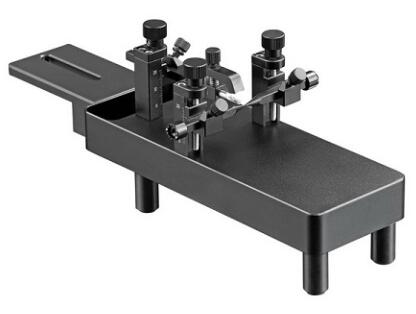|
||||||||||||||||||||||||||||||
| [发表评论] [本类其他产品] [本类其他供应商] [收藏] | ||||||||||||||||||||||||||||||
| 销售商: 上海玉研科学仪器有限公司 | 查看该公司所有产品 >> |
脑立体定位仪是神经解剖、神经生理、神经药理和神经外科等领域内的重要研究设备,脑立体定位仪用于对神经结构进行定向的注射、刺激、破坏、引导电极等操作,可用于帕金森氏病动物模型建立,癫痫动物模型建立,脑内肿瘤模型建立,学习记忆,脑内神经干细胞移植,脑缺血等研究。
脑立体定位仪是利用大小鼠颅骨外面的前囟点,即Bragma点,或其它参考点所规定的三维坐标系统,来确定皮层下某些神经结构的位置,通过固定在立体定位仪操作臂上的颅钻在特定三维坐标的神经结构的位置,钻孔打开颅骨,以便在非直视暴露下对其进行定向的刺激、破坏、注射药物、引导电位等研究。
数字型号的脑立体定位仪,能直观的显示出定位仪的三维坐标,并可以按键归零,移动操作臂后,显示特定位置的新的坐标,通过选配不同动物适配器可用于不同的小动物实验。
大鼠脑立体定位仪产品特点:
操作灵活、简便,标配大鼠适配器;
脑立体定位仪标尺是由激光雕刻,清晰易读,精确度为0.1mm;
脑立体定位仪操作臂移动范围(上下,左右,前后):三方向移动距离80mm;
垂直方向可90度转动,并随时锁定位置;
扩充能力很强,可增加操作臂,增加注射装置及颅钻等;
可以根据需要增加不同的固定器,用于多种动物;
具有以下优势:
· 标尺易读数
· 移动平滑
· 全方位调节电生理操作方便
· 配件多样,可选配各种动物适配器,麻醉罩以及颅钻
根据需求不同,有多种不同的型号可供选择:单臂型,双臂型,数显型,数控型,敬请来电咨询。
多种型号可供选择:
· 51600,标准脑立体定位仪(大鼠)
· 51650型,标准脑立体定位仪(大鼠)(带非穿刺耳杆)
· 51603型,双臂标准脑立体定位仪(大鼠)
· 51653型,双臂标准脑立体定位仪(大鼠)(带非穿刺耳杆)
· 51600U型,超精密标准脑立体定位仪(大鼠)
· 51650U型,超精密标准脑立体定位仪(大鼠)(带非损伤耳杆)
· 51653U型,超精密双臂标准脑立体定位仪(大鼠)(带非损伤耳杆)
· 51900型, 数显标准脑立体定位仪(大鼠)
· 51950,数显标准脑立体定位仪(大鼠)(带非穿刺耳杆)
· 51903,数显双臂标准脑立体定位仪(大鼠)
· 51953,数显双臂标准脑立体定位仪(大鼠)(带非穿刺耳杆)
· 51600M,电动标准脑立体定位仪(大鼠)
· 51601,定位仪基座,大鼠头部固定器
脑立体定位仪的主要构造:

51600,标准脑立体定位仪(大鼠):

51900型, 数显标准脑立体定位仪(大鼠):

51903,数显双臂标准脑立体定位仪(大鼠):

SA-103型便携式大鼠定位仪:

51730 型 便携式小鼠定位仪:

51730型便携是小鼠数字显示 定位仪:

小鼠及幼大鼠脑立体定位仪适配器
该小鼠适配器耳杆采用树脂材料,对尖端进行适合的锥度处理,能够牢固的夹紧小鼠头部又避免了采用不锈钢作为耳杆对小鼠颅骨的损伤,两侧耳杆的高度和门齿夹的高度均可自由进行调节,并带有刻度,适合不同的角度进行实验。

大鼠适配器
· 大鼠适配器是脑立体定位仪的标准配置,通过一对耳杆、鼻和门齿夹固定大鼠头部
· 可以通过燕尾槽上下移动 30mm
· 并具有100um的精度,水平方向可以达到50mm的移动距离,满足不同体重大鼠的固定
· 大鼠适配器默认配置为18度耳杆和门齿夹,可以选配45度耳杆

大鼠、小鼠两用型耳杆:

60° 小鼠耳杆



小动物脑立体定位仪部分参考文献:
1. Albéri, L., Lintas, A., Kretz, R., Schwaller, B., & Villa, A. E. (2013). The calcium-binding protein parvalbumin modulates the firing 1 properties of the reticular thalamic nucleus bursting neurons. Journal of neurophysiology, 109(11), 2827-2841.
2. Sonati, T., Reimann, R. R., Falsig, J., Baral, P. K., O’Connor, T., Hornemann, S., Aguzzi, A. (2013). The toxicity of antiprion antibodies is mediated by the flexible tail of the prion protein. Nature, 501(7465), 102-106.
3. Ali, I., O’Brien, P., Kumar, G., Zheng, T., Jones, N. C., Pinault, D., O’Brien, T. J. (2013). Enduring Effects of Early Life Stress on Firing Patterns of Hippocampal and Thalamocortical Neurons in Rats: Implications for Limbic Epilepsy. PLOS ONE, 8(6), e66962.
4. Bell, L. A., Bell, K. A., & McQuiston, A. R. (2013). Synaptic Muscarinic Response Types in Hippocampal CA1 Interneurons Depend on Different Levels of Presynaptic Activity and Different Muscarinic Receptor Subtypes. Neuropharmacology.
5. Bolzoni, F., Bączyk, M., & Jankowska, E. (2013). Subcortical effects of transcranial direct current stimulation (tDCS) in the rat. The Journal of Physiology.
6. Bolzoni, F., Bączyk, M., & Jankowska, E. (2013). Subcortical effects of transcranial direct current stimulation (tDCS) in the rat. The Journal of Physiology.
7. Babaei, P., Tehrani, B. S., & Alizadeh, A. (2013). Effect of BDNF and adipose derived stem cells transplantation on cognitive deficit in Alzheimer model of rats. Journal of Behavioral and Brain Science, 3, 156-161.
8. Gilmartin, M. R., Miyawaki, H., Helmstetter, F. J., & Diba, K. (2013). Prefrontal Activity Links Nonoverlapping Events in Memory. The Journal of Neuroscience, 33(26), 10910-10914.
9. Feng, L., Sametsky, E. A., Gusev, A. G., & Uteshev, V. V. (2012). Responsiveness to nicotine of neurons of the caudal nucleus of the solitary tract correlates with the neuronal projection target. Journal of Neurophysiology, 108(7), 1884-1894.
10. Clarner, T., Diederichs, F., Berger, K., Denecke, B., Gan, L., Van der Valk, P., Kipp, M. (2012). Myelin debris regulates inflammatory responses in an experimental demyelination animal model and multiple sclerosis lesions. Glia, 60(10), 1468-1480.
11. Girardet, C., Bonnet, M. S., Jdir, R., Sadoud, M., Thirion, S., Tardivel, C., Troadec, J. D. (2011). Central inflammation and sickness-like behavior induced by the food contaminant deoxynivalenol: A PGE2-independent mechanism.Toxicological Sciences, 124(1), 179-191.
12. Hruška-Plocháň, M., Juhas, S., Juhasova, J., Galik, J., Miyanohara, A., Marsala, M., Motlik, J. (2010). A27 Expression of the human mutant huntingtin in minipig striatum induced formation of EM48+ inclusions in the neuronal nuclei, cytoplasm and processes. Journal of Neurology, Neurosurgery & Psychiatry, 81(Suppl 1), A9-A9.
13. Brooks, S., Jones, L., & Dunnett, S. B. (2010). A29 Frontostriatal pathology in the (C57BL/6J) YAC128 mouse uncovered by the operant delayed alternation task. Journal of Neurology, Neurosurgery & Psychiatry, 81(Suppl 1), A9-A10.
14. Yu, L., Metzger, S., Clemens, L. E., Ehrismann, J., Ott, T., Gu, X., Nguyen, H. P. (2010). A28 Accumulation and aggregation of human mutant huntingtin and neuron atrophy in BAC-HD transgenic rat. Journal of Neurology, Neurosurgery & Psychiatry, 81(Suppl 1), A9-A9.
15. Baxa, M., Juhas, S., Pavlok, A., Vodicka, P., Juhasova, J., Hruška-Plocháň, M., Motlik, J. (2010). A26 Transgenic miniature pig as an animal model for Huntington’s disease. Journal of Neurology, Neurosurgery & Psychiatry, 81(Suppl 1), A8-A9.
您想了解更多详细资料吗?
请与我们联系:
TEL:021-35183767,18502129044
QQ:3007536621
Mail:yuyan0317@126.com
欢迎您的咨询!
专业的售后服务队伍
在保修期内,凡非人为因素导致仪器的故障均免费维护,售后服务中心将为用户免费更换配件,不收取任何费用,仪器保修期为:1年





